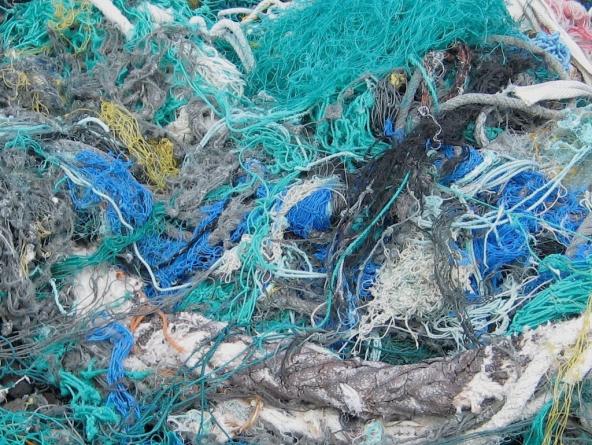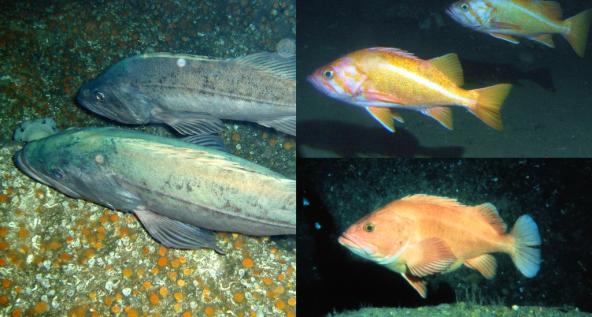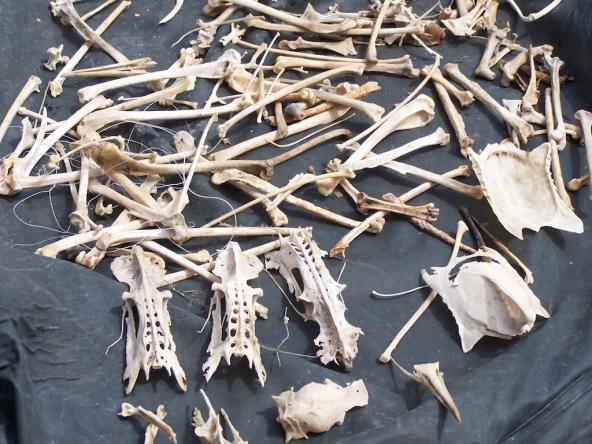
New technology is helping to remove deadly “ghost nets” that have been lost in the depths of Puget Sound. It is part of an effort that saves millions of animals every year, but managers say better reporting of these lost nets by fishermen is still needed.

Lost and abandoned fishing nets, which have killed millions of sea creatures in Puget Sound, still lurk in deeper, darker waters, where they continue to catch fish and crabs. But the quiet, unregulated killing has been quelled substantially since 2002, as divers have pulled up nearly 6,000 of these so-called “ghost nets.”
The challenge for the future is to find and quickly remove newly lost nets, while going after the difficult-to-remove nets still fishing in more than 100 feet of water. Programs are moving forward on both fronts.
Pulling nets for 13 years
The massive removal of ghost nets over a 13-year period ultimately cost the state and federal governments about $11 million. But if the 5,809 nets had been left in place, they might still be catching and killing up to 12 million animals each year, based on studies that measured the catch rates of abandoned nets.
“The magnitude of this effort often gets overlooked when considering the restoration of Puget Sound,” said Ginny Broadhurst, executive director of the Salish Sea Institute. “We talk about the Nisqually and the Elwha, but (net removal) is among the most important restoration efforts.”
The Nisqually Delta Restoration Project restored nearly 1,000 acres of wetlands, and the removal of two dams on the Elwha River opened up nearly 70 miles of salmon-spawning habitat. But pulling out derelict nets produced an immediate, long-lasting and cost-effective outcome, argues Broadhurst, who was involved in the early days of net removal as director of the Northwest Straits Commission.
Many of the lost nets appear to have been fishing continually for 20 to 30 years or more after getting snagged on rocky outcroppings or submerged pilings during the heyday of commercial salmon fishing in the 1970s and ‘80s, said Larry LeClair, a biologist and diver with the Washington Department of Fish and Wildlife.
Often made of monofilament nylon, the nets are nearly invisible in the water, where they decompose slowly, he said. Although they do become fouled with growth and tend to catch fewer animals over time, they can remain death traps for decades.

About 97 percent of the animals killed in the nets recovered so far turned out to be invertebrates — nearly 500,000 in all — and about 20 percent of those were crabs. But the nets also catch fish, birds and marine mammals. Out of the 5,809 nets removed from Puget Sound, work crews discovered 81 mammals (mostly harbor seals), 1,116 birds (mostly cormorants) and 5,716 fish of various kinds.
Furthermore, studies have shown that for every dead animal found in a net, many more had probably died and decomposed every year the net remained in the water.
As for costs, the Dungeness crabs alone that could have been caught if the ghost nets had remained in place were far more valuable than the cost of net removal, according to a study led by Kirsten Gilardi of the SeaDoc Society based at the University of California, Davis.
Going after deep-water nets
Gillnets, typically designed to catch salmon swimming by, capture relatively few salmon after the nets get snagged and are cut free to drift to the bottom of Puget Sound. But they do entrap multiple species of rockfish, including potentially killing yelloweye rockfish, listed as threatened under the Endangered Species Act, and bocaccio, listed as endangered.
The extensive effort to remove thousands of lost nets was declared a success in 2015, when practically all nets known to exist in less than 105 feet of water were finally gone. While yelloweye and bocaccio were not seen among the rockfish that perished in the shallow-water nets, those listed species could well be dying in the remaining nets in deeper water, where those fish are known to reside.

State and federal recovery plans for rockfish call for an intensified program to remove nets lost in deep water, where they may still be affecting the recovery of rockfish, lingcod and other deep dwellers.
Kyle Antonelis, senior fisheries analyst with Natural Resources Consultants, has been working on the derelict gear problem for more than a decade.
“We have spent a lot of time removing that gear down to about 100 feet or so, and I think we’re in a pretty good place with that,” he said, adding that advancements in technology — including side-scan sonar — allowed the search for lost nets to take a leap forward.
Now technology may be the key to future search and retrieval of nets deeper than 100 feet, he said. A 10-day pilot project in 2015 proved the value of using remotely operated vehicles, or ROVs, to remove nets, especially in areas that could be hazardous to divers. The project removed 10 nets under various conditions in four locations: Yukon Harbor and Port Madison in Central Puget Sound, along with Pile Point and Mitchell Bay in North Puget Sound.
Working in dark waters with strong tidal currents and steep, underwater cliffs may be the greatest challenges for removing nets in rockfish habitat, according to a report on the project. Under such conditions, ROVs must be powerful and maneuverable. Their arms must be equipped with tools for cutting, gathering and bundling nets and for attaching lines to haul them to the surface. Support vessels as well must be equipped to handle the adverse conditions.
“We have reports on more than 200 nets in deep water,” Antonelis said, adding that there could be many more. Known nets have been found by a variety of people: Crews searching for nets in shallow water, state biologists conducting rockfish surveys, recreational divers, and anglers fishing in deep water. Other nets were identified during a special project around the San Juan Islands that searched with special side-scan sonar able to peer into the depths.
An Army dive team, scheduled to retrieve some nets for training purposes, could remove some of the deep-water nets this summer, he noted. Also involved in that project are the Coast Guard and Washington Department of Natural Resources.
Because of the need for special equipment and the longer time it takes to work in deep water, the costs of future removals could far exceed the average $1,850 spent for pulling nets from shallow water, Antonelis said.
The problem of newly lost nets
As the challenge of removing deep-water nets continues to loom over rockfish recovery, the task of keeping up with newly lost nets has become surprisingly difficult, according to Jason Morgan, who manages the Derelict Fishing Gear Program for Northwest Straits Foundation.
Commercial fishers are required by state law to report lost nets within 24 hours, and several tribes have adopted similar regulations. It’s a no-fault approach. Fishers who report losing their nets are not held responsible for damages or cleanup. When feasible, removal crews will even return lost nets to their owners.
How to report derelict fishing gear
Online: Northwest Straits derelict fishing gear reporting system
By phone: Call 855-542-3935 (WDFW) or 360-733-1725 (Northwest Straits)
No penalties are associated with reporting lost fishing gear through the no-fault reporting system.
Since the launch of the Newly Lost Net Reporting, Response and Retrieval Program in 2012, about 70 newly lost nets have been confirmed as derelict, and nearly all have been removed. Of those, only seven were reported by the fishermen who lost them.
For the past two years alone, about 20 newly lost nets were confirmed, and none of those were reported by the fishermen who lost them. Because of the lack of reporting, it is difficult to estimate the number of nets still being abandoned in Puget Sound.
“We’re not getting buy-in from the fishermen,” Morgan said. “It’s a hard thing for me to wrap my head around. A common theme we hear is ‘we don’t lose nets.’ “
But the truth is that some commercial fishers are still losing nets. It is unfortunate that other people — such as boaters, scuba divers and shoreline residents — must call in the reports, Morgan said.
“I believe the fishing community to be among the most important and concerned stewards we have,” Morgan said, adding that he hopes to work with commercial fishers to overcome an apparent communications barrier and move toward the common goal of protecting and sharing natural resources.
The Northwest Straits Foundation continues to promote the reporting program among commercial fishers. Letters go out each year to all 270 or so gillnetters licensed by Washington state. Wallet cards and printed magnets are provided with phone numbers to call in lost nets.
For tribal fishers, the foundation has worked with tribal managers to get the word out to their fishers. Some tribes have been more communicative and helpful than others, Morgan said.
Calls to the foundation’s hotline normally receive a quick response, including an investigation and retrieval whenever possible, Morgan said.
“We try to get out and take action before the net catches too many fish or moves somewhere else,” he said.
The foundation also is involved in the problem of lost crab pots, primarily promoting education through videos and written information directed at recreational crabbers. Failure to properly locate and handle crab pots is blamed for the loss of nearly 12,000 crab pots each year in Puget Sound. A project to recover lost crab pots from heavily trapped areas is scheduled to begin in May.
Busting the ghost nets
For years, the extent of the derelict net problem went largely unrecognized. Scuba divers would tell of swimming in murky waters and coming face-to-face with nets filled with the rotting carcasses of dead animals.

During the 1990s, the Department of Fish and Wildlife began keeping track of reports describing where people had seen abandoned nets, but there was no organized program to remove them. Occasionally, state divers would pull up a net, and sometimes volunteers would recover them from shore. But agency officials have long discouraged removal by untrained divers, because of accidents in which divers have died after becoming entangled and running out of air.
In 2002, the Washington Legislature funded an effort to develop guidelines for the safe removal and disposal of derelict nets with minimal damage to the environment. Lawmakers also launched a new initiative to begin removing nets from Puget Sound, an initiative that continues to this day.
One of the first areas to undergo cleanup during the fall of 2002 was a prime fishing ground near Lummi Island in North Puget Sound. Numerous abandoned gillnets had been killing a variety of sea creatures as the nets accumulated over many years, Morgan said.
After pulling several nets off the rocks and hauling them to the surface, Morgan recalls seeing piles of bones from seabirds that had perished in the nets.
“It was then,” he said, “that we realized how big this issue really was.”

